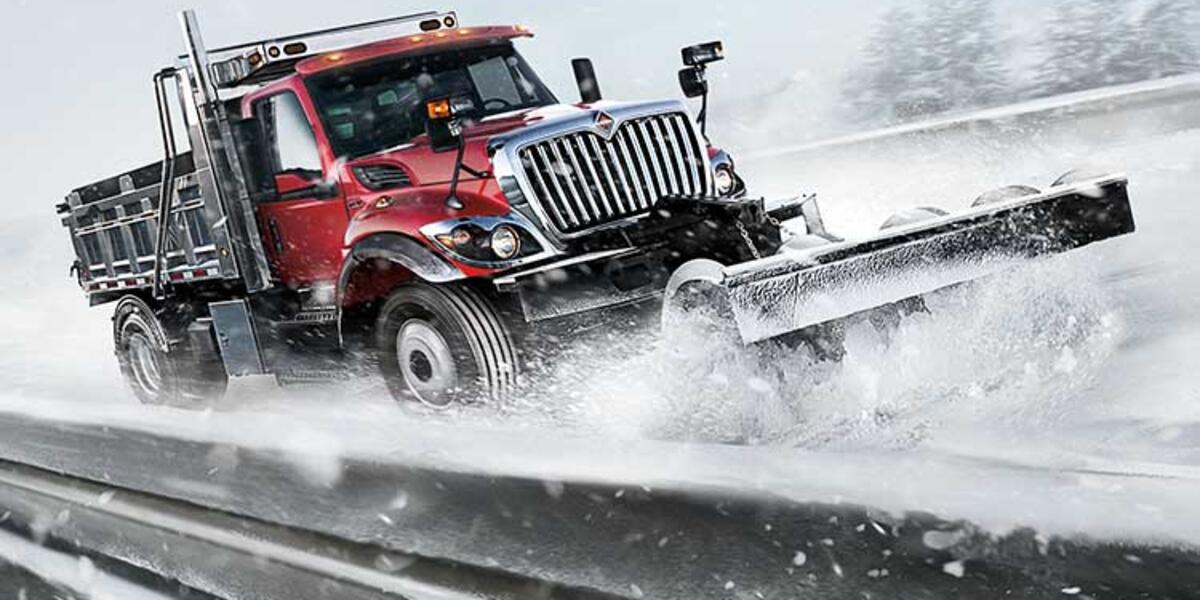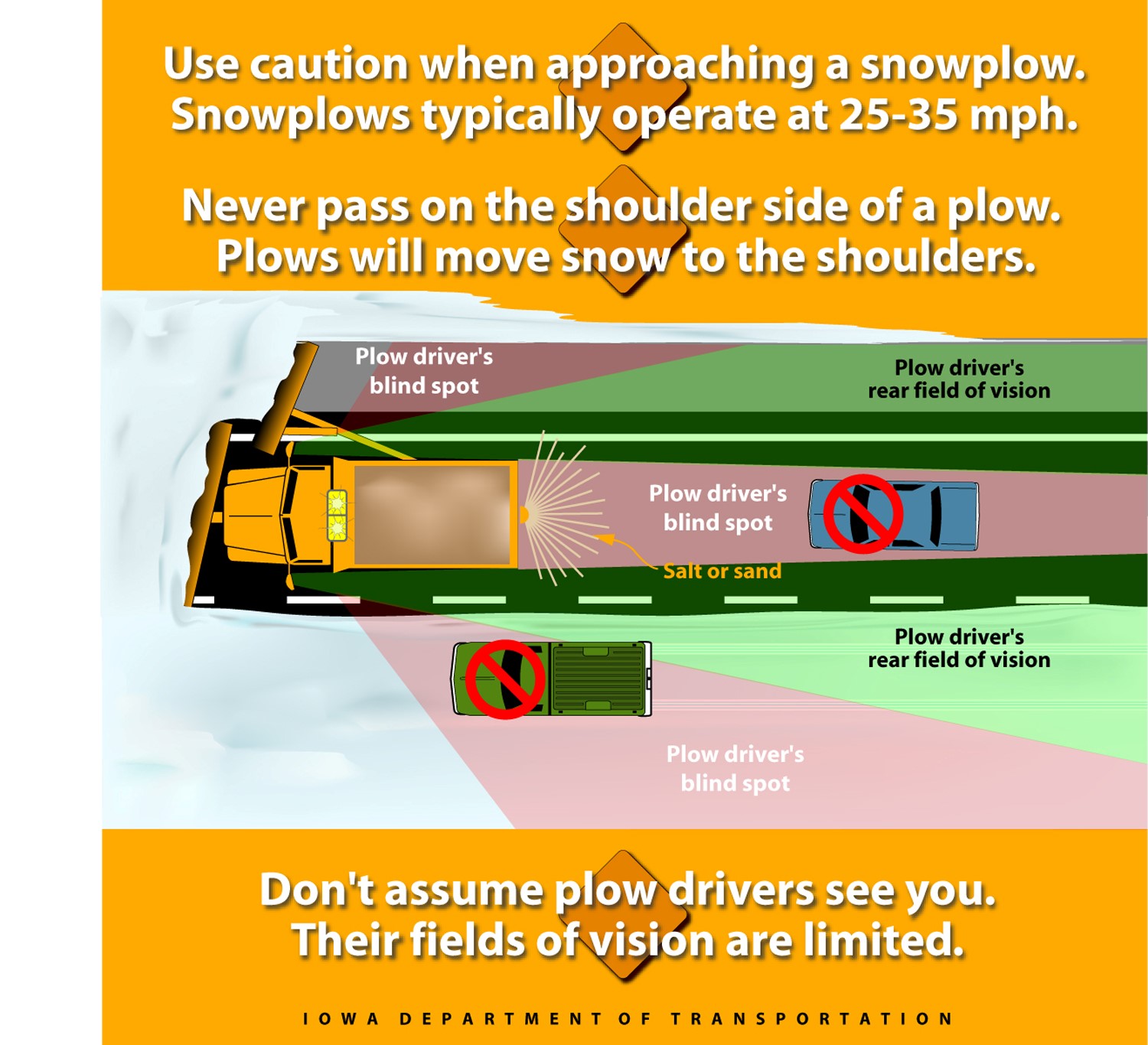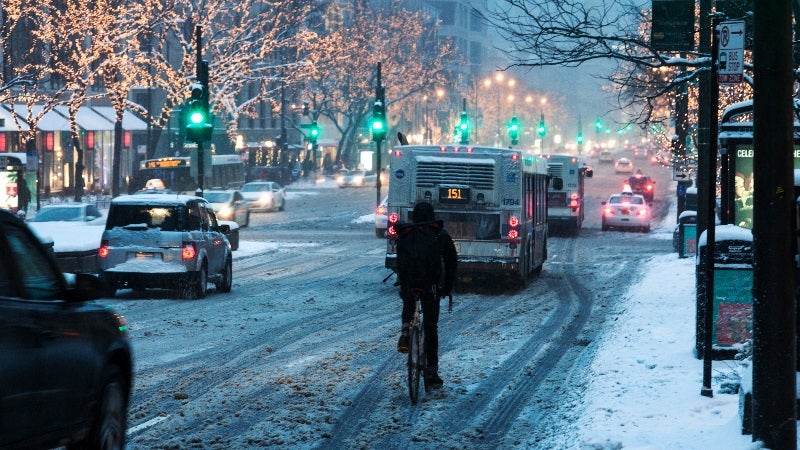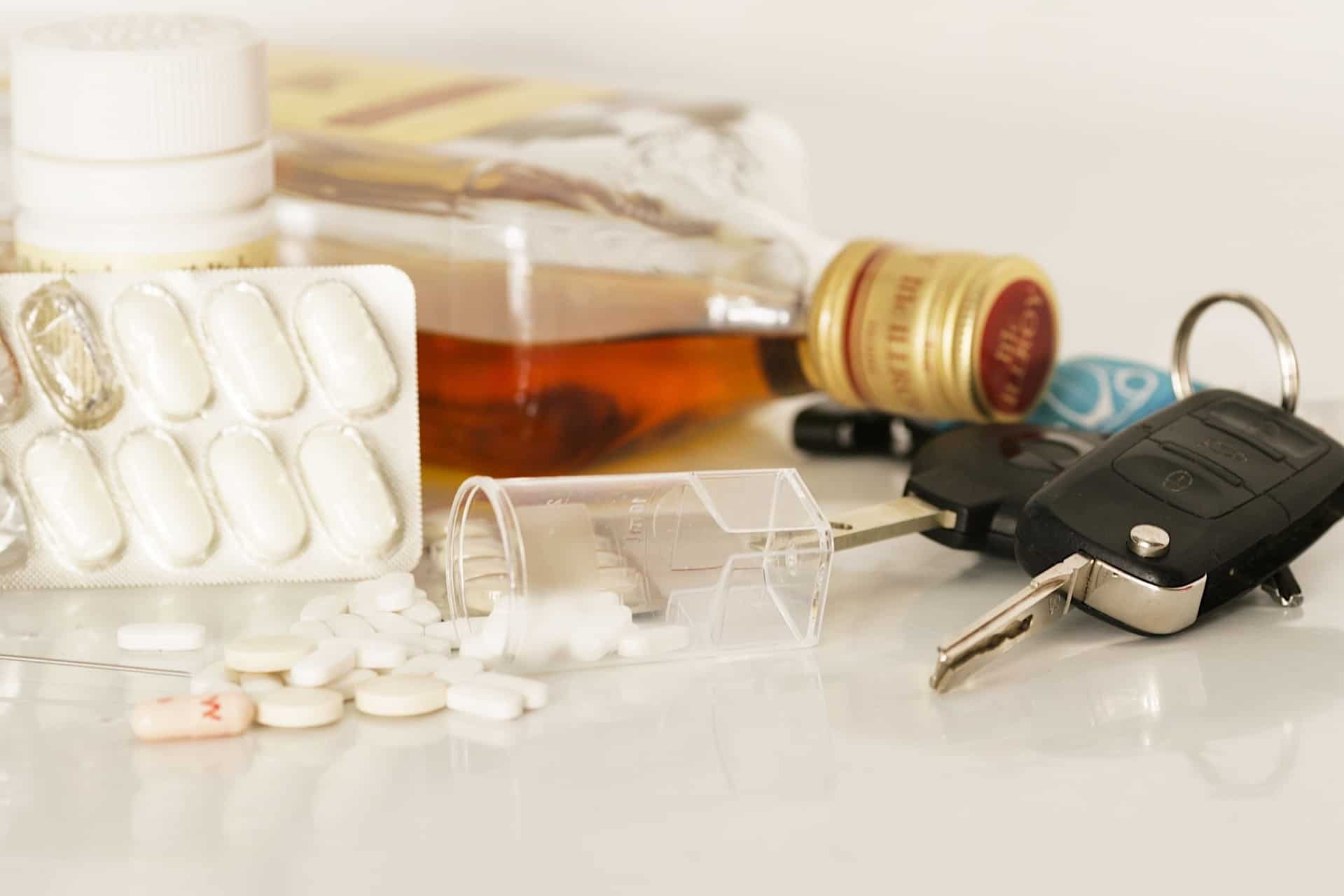This week, much of the Midwest will experience another significant snowstorm. During winter storms, snowplows work around the clock to make roads passable. These large vehicles can present a hazard for drivers who follow too closely. Observe these tips to stay safe while giving snowplow operators room to do their jobs.
- Keep well back from snowplows
Plow drivers can't see directly behind their trucks. Sometimes they must stop or back up. Staying a safe distance behind a snowplow will protect you from possible injury and protect your car from sanding material that plows spread on slick roadways. - Know where the snowplow is on multi-lane highways
The plow could be in either lane or on the shoulder. Watch for snowplows on interstate ramps and "authorized vehicle only" turnarounds. - Never drive through a snow cloud or whiteout conditions
You can't be sure if such conditions are caused by crosswinds or by a snowplow; so, be patient. Snowplow operators periodically pull over to allow traffic to pass.
Snowplow operators are extremely safety-conscious, but they need your help. Stay back and let them safely do their job of clearing the road for you. Don't take a chance. Don't crowd the plow!
Holiday Driving Tips
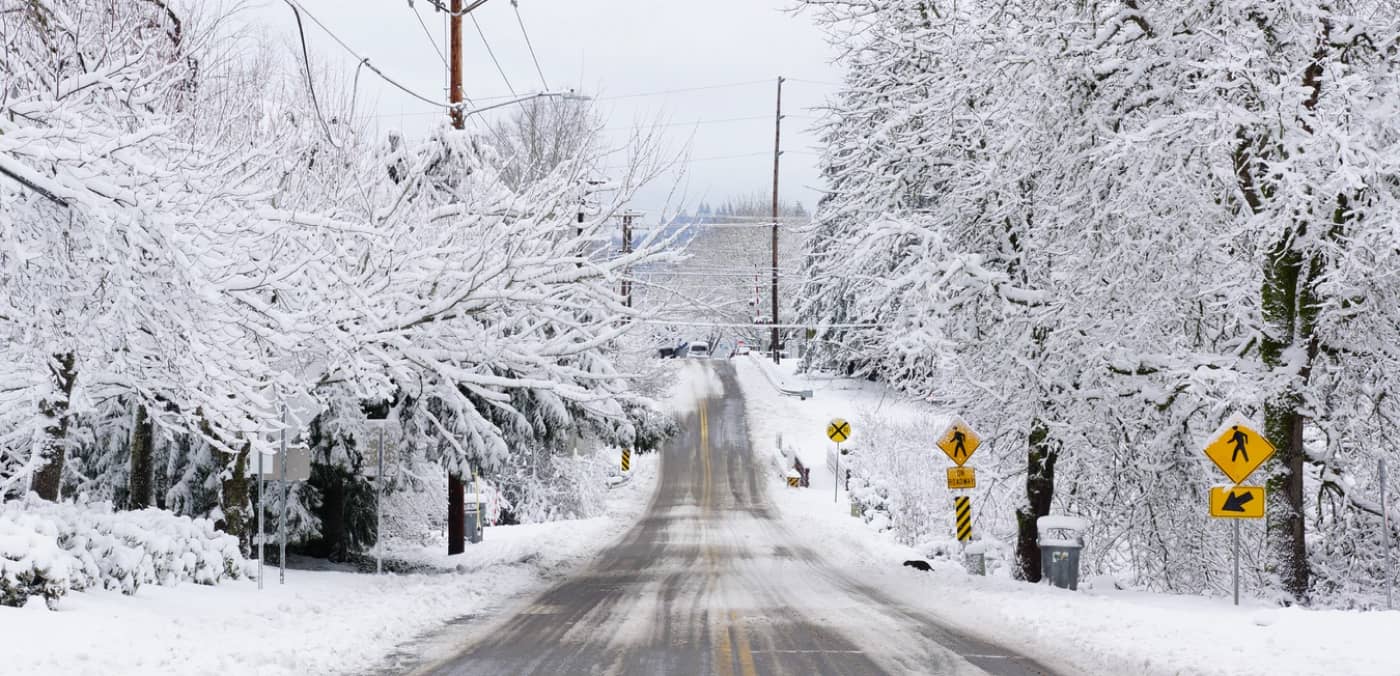 Holiday events and celebrations can be exciting times for family and friends to get together. But get-togethers with family and friends can turn into tragedies when people are killed or injured in traffic crashes. As the holiday season is approaching, motorists need to be mindful of actions that will make their holiday travel safer. Drivers can protect themselves and their passengers by following these holiday travel rules. Before you start your trip, make sure your vehicle is tuned up and in good shape for travel. This is especially important for winter driving conditions. Restrain yourself and your passengers properly in seat belts and car safety seats. Remember, the rear seat is the safest place for children of any age to ride. Be flexible in setting your travel plans. Leave early if you can avoid the peak traffic hours. If snow is predicted during the time you plan to travel, change your schedule. It is better to reschedule your get-together than to risk the lives of traveling family or friends. Stay fresh and alert when driving. Take plenty of breaks and do not push yourself to meet an unrealistic schedule. If you get tired, pull off the road into a rest area or business, get out of the car for some fresh air, buy something to refresh you, or just relax until you feel revived. If that doesn’t work, find a motel or campground where you can spend the night. Forty-one percent of fatal traffic accidents are single-vehicle crashes. These crashes most often occur during the late-night/early morning hours and the late afternoon hours to drivers who are tired, have consumed alcohol, or both. Keep your speed down. Give yourself plenty of time and distance to react to the traffic around you. Let impatient and aggressive drivers pass you or go through the intersection ahead of you so that you control the situation. Do not pass if you cannot see enough clear road to pass safely. If there will be drinking at your holiday get-together, choose a designated driver who will remain alcohol-free. Because driving requires your full attention, pull off the road if you must use your cellular phone.
Holiday events and celebrations can be exciting times for family and friends to get together. But get-togethers with family and friends can turn into tragedies when people are killed or injured in traffic crashes. As the holiday season is approaching, motorists need to be mindful of actions that will make their holiday travel safer. Drivers can protect themselves and their passengers by following these holiday travel rules. Before you start your trip, make sure your vehicle is tuned up and in good shape for travel. This is especially important for winter driving conditions. Restrain yourself and your passengers properly in seat belts and car safety seats. Remember, the rear seat is the safest place for children of any age to ride. Be flexible in setting your travel plans. Leave early if you can avoid the peak traffic hours. If snow is predicted during the time you plan to travel, change your schedule. It is better to reschedule your get-together than to risk the lives of traveling family or friends. Stay fresh and alert when driving. Take plenty of breaks and do not push yourself to meet an unrealistic schedule. If you get tired, pull off the road into a rest area or business, get out of the car for some fresh air, buy something to refresh you, or just relax until you feel revived. If that doesn’t work, find a motel or campground where you can spend the night. Forty-one percent of fatal traffic accidents are single-vehicle crashes. These crashes most often occur during the late-night/early morning hours and the late afternoon hours to drivers who are tired, have consumed alcohol, or both. Keep your speed down. Give yourself plenty of time and distance to react to the traffic around you. Let impatient and aggressive drivers pass you or go through the intersection ahead of you so that you control the situation. Do not pass if you cannot see enough clear road to pass safely. If there will be drinking at your holiday get-together, choose a designated driver who will remain alcohol-free. Because driving requires your full attention, pull off the road if you must use your cellular phone.Alcohol, Drivers, and the Holidays!
Now is a good time to remind your drivers of the consequences of drinking during the holiday season and what effect their actions can have on their CDL or operator's license and ultimately their employment with your company. Advise your drivers to use caution when indulging in alcoholic beverages and have a designated driver to not only protect their license and job but the motoring public. The FMCSA regulations are specific that a CDL driver while operating any type of motor vehicle is convicted of being under the influence of alcohol as described by state law will be disqualified from operating a commercial motor vehicle for one year. A second conviction would disqualify the driver from operating a commercial motor vehicle for life
When is Alcohol Use Prohibited?
Alcohol is a legal substance; therefore, the rules define specific prohibited alcohol-related conduct. Performance of safety-sensitive functions is prohibited:
- While using alcohol.
- While having a blood alcohol concentration of 0.04 percent or greater as indicated by a breathalyzer test.
- Within four hours after using alcohol. In addition, refusing to submit to an alcohol test or consuming alcohol within eight hours after an accident or until tested (for drivers required to be tested) are prohibited.
FMCSA Issues Guidance on Submitting DUIs to Drug and Alcohol Clearinghouse
The Federal Motor Carrier Safety Administration has issued guidance on new requirements contained in the agency’s October 7, 2021, final rule on its Drug and Alcohol Clearinghouse.
The guidance notes that the new Clearinghouse rule does not change any of the requirements for employers to query CDL and commercial learner’s permit holders and report drug and alcohol program violations. All requirements previously established by the first Clearinghouse rule remain in place.
But the guidance notes that the new rule includes an update regarding actual knowledge violations. Companies that know that one of their drivers received a DUI while operating a CMV must submit that citation to the Clearinghouse even if the citation does not result in a conviction. The following question and answer have been added to the Clearinghouse website to summarize this change.
Question
If a CDL driver’s employer is aware that the driver received a traffic citation for driving a CMV while under the influence of alcohol or controlled substances, the employer must report this to the Clearinghouse as actual knowledge of prohibited use of drugs or alcohol. If the citation does not result in a conviction, may the driver petition to have this violation removed from their Clearinghouse record?
Answer
Effective November 8, 2021, an actual knowledge violation, based on the issuance of a citation for DUI in a CMV, will not be removed from the Clearinghouse when the citation does not result in a conviction.
In the final rule published on October 7, 2021 (86 FR 55718), FMCSA clarified that a driver subject to FMCSA’s drug and alcohol use and testing requirements, who has been issued a traffic citation (or another charging document) for DUI in a CMV, has violated 49 CFR part 382, subpart B. Accordingly, the 2021 final rule amends the regulation to state that a report of actual knowledge of prohibited use of drugs or alcohol, based on the issuance of DUI in a CMV, will remain in the Clearinghouse for 5 years, or until the driver has completed the return-to-duty process, whichever is later, regardless of whether the driver is ultimately convicted of the DUI offense. Drivers who are not convicted of the offense may petition to submit documentary evidence of non-conviction to their Clearinghouse record.

